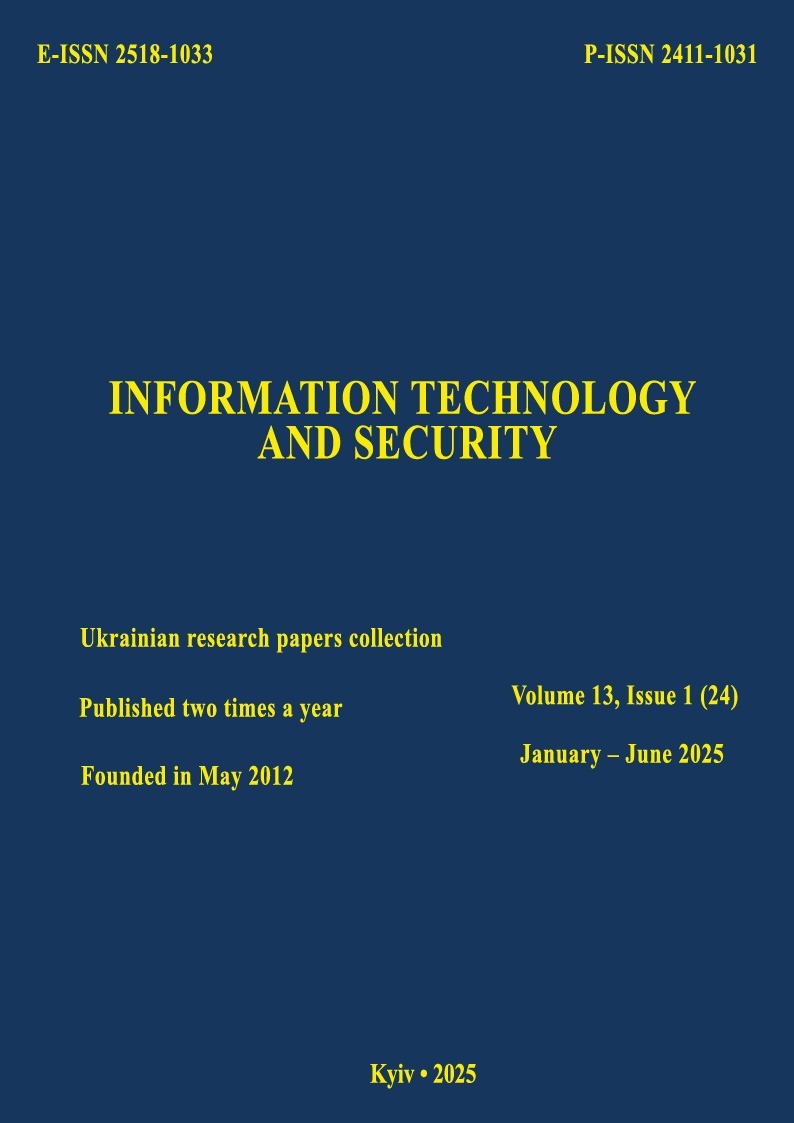Training a neural network to identify objects by parameters in non-overlapping spaces
DOI:
https://doi.org/10.20535/2411-1031.2025.13.1.328972Keywords:
neural network training, quality criteria for object distinction, errors of the first and second kind of decision theory, indicators of qualityAbstract
The present moment is characterised by the active use of digital information processing technologies in electronic communications systems. An important task in this case is to develop methods and algorithms for deciding whether a certain object O belongs to one or another m-th class: Om, m =1, 2, ..., M, M ≥ 2 – number of classes. This task can be solved with the use of neural networks that implement the processing of k conditional estimates of physical parameters xk1/m, xk2/m, …, xkn/m, …, xkN/m objects, k =1, 2, …, K, K – is the maximum number of training steps, n is the current physical parameter that characterises the object and is an input to the neural network), N – is the number of such physical parameters, N ≥ 2. Contingent valuations xk1/m, xk2/m, …, xkn/m, …, xkN/m are random, depend on the energy characteristics of the impacts and dynamically change over time, and the decision to determine whether an object O belongs to one or another m-th class involves the use of neural networks, which have the properties of learning and self-learning. Suppose that, from the energy point of view, the input influences are powerful enough to assign the object O to one or another m-th class Om . Thanks to the expert's ability to accurately determine the m-th class after receiving the k-th conditional vector of physical parameter estimates xk/m, the m neural network will be trained by refining the lower and upper limits of displacements in the first layers of perceptrons for each m-th class Q1m min and Q1m max, after the next estimates of physical parameters are received and the expert provides the real value of the object O belonging to class m. The article solves the inverse problem of finding, Qm min, Qm max, which ensure the specified quality indicators in neural network training for the minimum number of steps K. The article considers the implementation of a three-layer neural network trained by an experienced expert to solve the problem of object identification by several parameters. The solution to the problem of object identification by classes is presented for known distributions of conditional estimates of physical parameters. The problem of object identification by classes at infinite signal-to-noise ratios in the process of estimating physical parameters is solved. The expressions that determine the perceptron displacement for the problem of object identification by classes when the spaces of true values of input parameters do not intersect are found.
References
A. M. Reznik, “Non-Iterative Learning for Neural Networks”, in Proc. Int. Joint Conf. Neural Netw., Washington, DC, USA, 1999, no. 548, pp. 1374-1379. doi: https://doi.org/10.1109/IJCNN.1999.831163.
What is Perceptron? A Beginners Guide for 2023. [Online]. Available: https://www.simplilearn.com/tutorials/deep-learning-tutorial/perceptron. Accessed on: Feb. 15, 2025.
What is machine learning? [Online]. Available: https://www.ibm.com/topics/machine-learning. Accessed on: Jan. 17, 2025.
What is deep learning and how does it work? [Online]. Available: https://www.techtarget.com/searchenterpriseai/definition/deep-learning-deep-neural-network. Accessed on: Feb. 12, 2025.
What Is Deep Learning? [Online]. Available: https://www.mathworks.com/discovery/deeplearning.html. Accessed on: Feb. 12, 2025.
O. M. Riznyk, O. A. Kalyna, O. S. Sychev, O. G. Sadova, O. K. Dekhtyarenko, and A. O. Galynska, “Multifunctional neurocomputer NeuroLand”, Math. Mach. & Sys., no. 1, pp. 36-45, 2003. [Online]. Available: http://www.immsp.kiev.ua/publications/2003_1/index.html. Accessed on: Jan. 18, 2025.
D. V. Evgrafov, Distribution of the absolute maximum of a random field in the theory of analysis of radio engineering systems. Monograph. Kyiv, Ukraine: Igor Sikorsky Kyiv Polytechnic Institute, Polytechnic Publishing House, 2021.
Y. Shchypskyi, O. Prozor, “Analysis of neural network technologies for the development of intelligent chatbots in social networks”, in Proc. XLVІІX VNTU Scien. & Tech. Conf., Vinnytsia, 2020, pp. 1-3. [Online]. Available: https://conferences.vntu.edu.ua/index.php/allfitki/all-fitki-2020/paper/view/8759/7556. Accessed on: Feb. 19, 2025.
Machine learning algorithms. Deep neural networks in problems of mechanics of continuous media: Study guide. Kyiv, Ukraine: Taras Shevchenko National University of Kyiv, 2024.
S. O. Subbotin, Neural networks: theory and practice. Textbook. Zhytomyr, Ukraine: O. O. Yevenok Publ., 2020.
S. Abdoli, P. Cardinal, and A.L. Koerich, “End-to-end environmental sound classification using a 1D convolutional neural network”, Mach. Learn., 2019. doi: https://doi.org/10.48550/arXiv.1904.08990.
O. O. Miroshnyk, and A. V. Svyatobatko, “Modelling a neural network for the tasks of predicting physical parameters”, Proc. of the Tauride State Agrotechnology University, vol. 5, no. 13, pp. 34-40, 2013. [Online]. Available: https://nauka.tsatu.edu.ua/print-journals-tdatu/135/13_5/zmist.pdf. Accessed on: Feb. 9, 2025.
Downloads
Published
How to Cite
Issue
Section
License
Copyright (c) 2025 Collection "Information Technology and Security"

This work is licensed under a Creative Commons Attribution 4.0 International License.
The authors that are published in this collection, agree to the following terms:
- The authors reserve the right to authorship of their work and pass the collection right of first publication this work is licensed under the Creative Commons Attribution License, which allows others to freely distribute the published work with the obligatory reference to the authors of the original work and the first publication of the work in this collection.
- The authors have the right to conclude an agreement on exclusive distribution of the work in the form in which it was published this anthology (for example, to place the work in a digital repository institution or to publish in the structure of the monograph), provided that references to the first publication of the work in this collection.
- Policy of the journal allows and encourages the placement of authors on the Internet (for example, in storage facilities or on personal web sites) the manuscript of the work, prior to the submission of the manuscript to the editor, and during its editorial processing, as it contributes to productive scientific discussion and positive effect on the efficiency and dynamics of citations of published work (see The Effect of Open Access).

